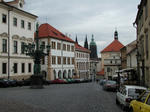 Hradcany was founded in 1321
Hradcany was founded in 1321, during the reign of John of Luxemburg, with the purpose of housing all the employees of the Castle nearby.
The gothic part of this district disappeared during the 1400's and overall because of the devastating fire of 1541, which started at the Mala Strana Square but reached also the upper part of this district.
Hradcany depended directly on the Castle until 1598 when Rudolf II. allowed the founding of a town hall. From that year, the district was an independent town and it became part of the city of Prague in 1774.
This district as well as Mala Strana has preserved its renaissance and baroque look, never accepting the intrusion of the Modern.
Nearby Prague Castle there is the town Hradcany. Here it is possible to see an exhibition of European art of the National Gallery housed in
the Sternberg Palace. You will see works by Tintoretto, Canaletto, El Greco, Durer, Rembrandt..
Opposite the Sternberg Palace it is possible to visit an exhibition of
the Historical Military Museum.
Closely
the Ministry of Foreign Affairs we will visit
the Loreto church.
It's possible to visit
the Strahov library, which is one of the most beautiful historical libraries in Europe.
Strahov Monastery
Pohorelec, Praha 1
Monastery of the Premonstratensian Order at Strahov, originally Romanesque, with the Church of Our Lady and with the building of Strahov Library. The historical library contains an early Baroque Theological Hall of 1671 - 79 and Classicist Philosophical Hall of 1785 - 94, decorated with frescoes of A. Maulbertsch.
Loretto (Loreta)
 Loretanske namesti 7, Praha 1, Phone: 02/2451 0789
Loretanske namesti 7, Praha 1, Phone: 02/2451 0789
The Loreto is probably the most outlandish piece of baroque fantasy in Prague. Its attractions include a painting of a bearded lady, the skeletons of two female saints, an ecclesiastical extravagance, and the highest concentration of cherubs to be found anywhere in the city. It was built as part of a calculated plan to reconvert the masses to Catholicism after the Thirty Years' War. At its heart is a small chapel, the Santa Casa, whose history is so improbable that it quickly gained cult status. The story goes that the original Santa Casa was the home of Mary in Nazareth until it was miraculously flown over to Loreto in Italy by angels, spawning a copycat cult all over Europe (there are 50 in Bohemia alone). This one, from 1626-31, boasts two beams and a brick from the "original", as well as a crevice left on the wall by a divine thunderbolt that struck an unfortunate blasphemer. The red colour scheme makes it look more like a place to hold a black mass than a virgin's boudoir. The shrine was a particular hit with wealthy ladies who donated the money for baroque maestri Christoph and Kilian Ignaz Dientzenhofer to construct the outer courtyards and the Church of the Nativity (1716-23) at the back. They also sponsored the painting of St Wilgefortis, the patron saint of unhappily married women, who grew a beard as an extreme tactic to get out of marrying a heathen (in the corner chapel to the right of the main entrance), and that of St. Agatha the Unfortunate, who can be seen carrying her severed breasts on a meat platter (in the Church of the Nativity). The famous diamond monstrance, designed in 1699 by Fischer von Erlach and sporting some 6,222 stones, is in the treasury.
Cernin Palace
Loretanske namesti, Praha 1
An early Baroque palace, works carried out by Francesco Caratti in 1669 - 87. The present day seat of the Ministry of Foreign Affairs.



 Průvodce
Průvodce 





